Stabilized Deuterium UV Light Source
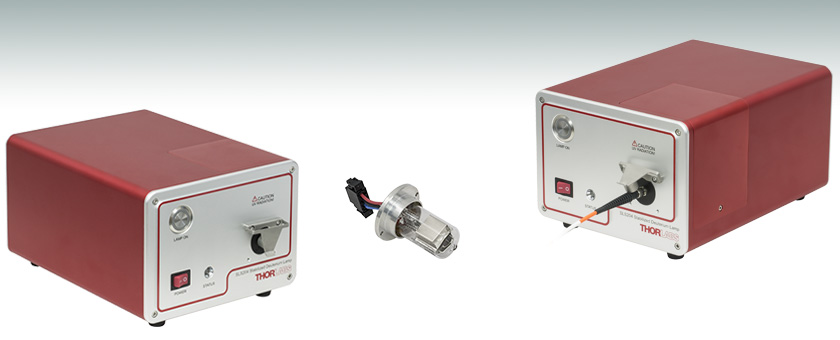
- 200 - 700 nm Output with Continuous UV Spectrum from 200 - 400 nm
- Long 2000 Hour Lifespan
- SMA905 Fiber-Coupled Output
- Compatible with SM1 Components and 30 mm Cage Systems
SLS204
Deuterium Light Source
Application Idea
SLS204 Shown with Included M114L01 Solarization-Resistant Patch Cable
SLS254B
Replacement Deuterium Bulb (Not to Scale)

Please Wait
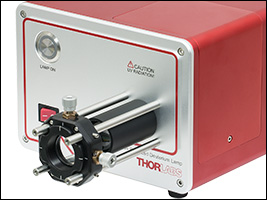
Click to Enlarge
The fiber adapter and dust cap on the output port can be removed to use 30 mm cage system components and SM1-threaded components with the SLS204.
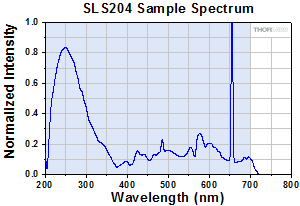
Click to Enlarge
The measured spectral power distribution for the SLS204 Light Source. The blue-shaded region indicates the lamp's operating wavelength range. Click here for raw data.
Features
- Deuterium Light Source for 200 - 700 nm
- Stabilized 30 W Bulb Intensity Using Closed-Feedback Loop
- 0.02% Per Hour and 0.1% Per °C Output Power Drift
- SMA905 Fiber-Coupled Output with Dust Cover
- Internally SM1-Threaded (1.035"-40) Aperture
- Compatible with 30 mm Cage Systems and Ø1" Lens Tubes
- Replacement Light Bulb Available Separately
- Location-Specific Power Cord Included
Thorlabs' SLS204 Deuterium Light Source provides stable illumination from 200 nm to 700 nm. The strong continuous spectrum at short UV wavelengths (200 - 400 nm) makes this an ideal source for UV spectroscopy applications. A closed-loop feedback system stabilizes the 30 W bulb which is coupled into a SMA905 bulkhead for connecting to a fiber patch cable. A low-noise fan cools the light source and bulb enabling continuous operation for >50 hours (see the Graphs tab for lamp stability over time). Each SLS204 includes a location-specific power cord.
The SLS204 includes a M114L01 Solarization-Resistant Multimode Fiber Patch Cable. The light source has a typical fiber-coupled output power of 0.1 mW using the included patch cable and a typical 2 mW output power when used in a free-space configuration.
Within the light source housing is a deuterium bulb and a series of UV fused silica lenses to focus the emitted light on the fiber port. Within the bulb, an electric arc is generated that excites the gaseous deuterium causing molecular emission of a continuous UV spectrum. In addition, two other major spectrum peaks occur at 486 nm and 656 nm. The deuterium bulb in the SLS204 has a lifetime of 2000 hours. Replacement bulbs are available for purchase separately. Please see the Bulb Replacement tab for detailed instructions on how to replace the bulb in these lamps.
The SLS204 comes equipped with an SMA905 fiber adapter on the output aperture and a hinged dust cap. The adapter can be removed to expose internal SM1 (1.035"-40) threading that is compatible with other externally SM1-threaded fiber adapters. The dust cap can also be removed using the included 5/64" hex key or balldriver in order to access the two of the four 4-40 tapped holes for 30 mm cage rods that provide compatibility with 30 mm cage system components. Using the cage system, it is possible to incorporate various optic mounts that are centered along the optical center of the lamp (as seen in the image above).
Please note that the SLS204 generates high-intensity UV light. Wear appropriate eye protection and do not look directly at the output during operation. Do not place hands or body parts in the path of the beam.
| Item # | SLS204 |
|---|---|
| Wavelength Range | 200 - 700 nm |
| Bulb Electrical Power | 30 W |
| Output Fiber | M114L01 Patch Cable (Included) Ø600 µm, 0.22 NA, SMA905 Connectors |
| Fiber-Coupled Output Powera | 0.1 mW (Typical) |
| Free-Space Output Powerb | 2 mW (Typical) |
| Output Power Drift | 0.02% Per Hour (Typical) 0.1% Per °C (Typical) |
| Output Power Stabilityc | <0.06% |
| Bulb Lifetimed | 2000 h |
| Power Supply | 100 - 240 VAC, 50 - 60 Hz |
| Operating Temperature | 0 - 40 °C |
| Storage Temperature | -15 - 70 °C |
| Dimensions (L x W x H) | 246.3 mm x 170.0 mm x 129.8 mm (9.70" x 6.69" x 5.11") |
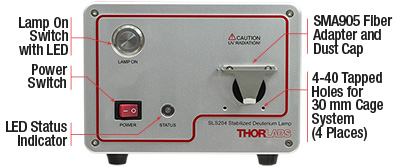
Click to Enlarge
SLS204 Front Panel
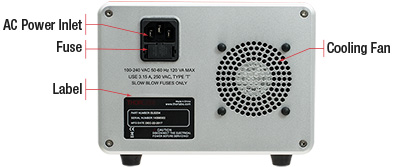
Click to Enlarge
SLS204 Back Panel
| Patch Cable Item # | Wavelength Range | NA | Core Diameter | Cladding Diameter | Coating Diameter | Bend Radius (Short Term) | Bend Radius (Long Term) |
|---|---|---|---|---|---|---|---|
| M114L01 | 180 - 1200 nm | 0.22 | 600 ± 12 µm | 660 ± 6 µm | 750 ± 20 µm | 53 mm | 106 mm |
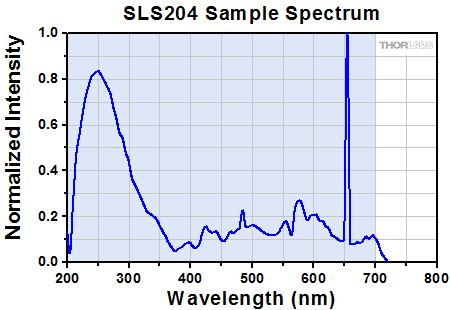
Click to Enlarge
The measured spectral power distribution for the SLS204 Light Source. The blue-shaded region indicates the lamp's operating wavelength range. The continuous spectrum of the deuterium lamp extends from 200 nm - 400 nm. Please note that the lower apparent intensity of the output is due to detection limitations from 300 to 400 nm and <225 nm.
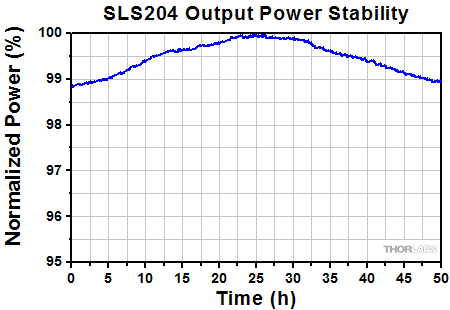
Click to Enlarge
The output of the SLS204 over 50 hours of continuous operation. This graph does not include 45 minutes of warm-up to ignite the source and stabilize the output.
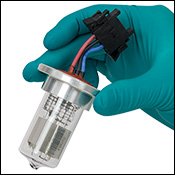
Click to Enlarge
The bulb can be held by the metal casing with gloved hands. Avoid making contact with the bulb envelope directly.
Bulb Handling
The bulbs used in a deuterium lamp operate at a very high temperature. If handled incorrectly, they will become a serious hazard to users and could potentially cause severe injury. It is critical to follow safety instructions when handling them.
The guidelines below describe correct bulb handling.
- Any dust or grease on the bulb will compromise the integrity of the bulb envelope, increasing the chance that the bulb will burst. Clean any dirt, oil, or lint away from the bulb with alcohol and a lint free cloth or tissue.
- Never bump, drop, apply excessive stress, or scratch the bulb. This could cause it to burst.
- Always transport the bulb in the provided protective case or cover until installation.
- Save the protective case or cover and packaging materials (box) for bulbs that have been used to their rated service life.
- Always wear gloves when handling the bulb; never hold the bulb by its envelope (see photo to the right). Thorlabs offers gloves that can be used for bulb handling.
- The bulb generates very high-intensity UV light output; wear the appropriate laser safety glasses during operation.
- The bulb gets very hot during operation. Always wait at least 10 minutes for the bulb to cool down before handling the bulb after operation.
- Electrostatic discharge (ESD) protection is recommended when handling the bulb.
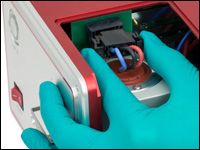
Click to Enlarge
Step 3: Press Clamps and Pull Connector
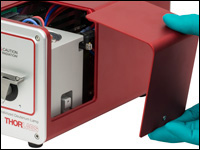
Click to Enlarge
Step 2: Remove the Bulb Cover
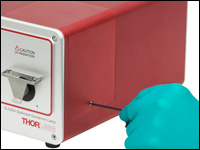
Click to Enlarge
Step 1: Loosen Panel Screw
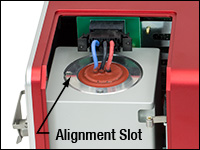
Click for Details
Step 6: Replace with New Bulb
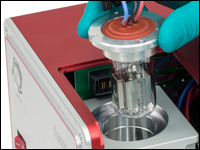
Click to Enlarge
Step 5: Remove Bulb from Holder
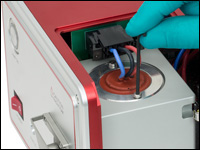
Click to Enlarge
Step 4: Unscrew Bulb
Bulb Installation
The instructions and photos to the right detail the recommended procedure for replacing the bulbs in the SLS204 Deuterium Light Source. Do not attempt to change the light bulb while the bulb and unit are hot. Allow at least 10 minutes after turning the lamp off before attempting to replace the light bulb.
We strongly recommend wearing gloves when replacing the bulb to prevent skin oils from being deposited onto the bulb. If you suspect the bulb is dirty, carefully clean it with alcohol before connecting it to a power supply.
Open the Lamp Housing
- Use the included 2 mm (5/64") hex key to loosen the panel screw on the side of the light source.
- Hold the bulb cover and pull to remove it.
Remove the Old Bulb
- Press the two clamps on the sides of the connector at the same time and pull the connector from the socket to electrically disconnect the bulb.
- Use the 2 mm (5/64") hex key to remove the two cap screws holding the bulb within the lamp.
- Pull out the bulb by the metal housing; do not touch the bulb envelope.
Install the New Bulb
- Place the replacement bulb within the lamp aligning the slot in the bulb base with the pin on the front side of the bulb holder. Tighten the two cap screws with the hex key and plug in the black connector to connect the bulb. Afterwards, replace the side panel and tighten the panel screw with the hex key.
| Posted Comments: | |
Raymond Garcia
(posted 2023-12-18 17:37:57.87) to whom it may concern: can you tell me it this product, SLS204, is UL-listed? Thank you.
ray ksosnowski
(posted 2023-12-21 09:24:51.0) Thank you for contacting Thorlabs. The SLS204 is not UL-listed. Chih-Chun Hsu
(posted 2022-01-19 03:40:40.417) Hello sir,
We bought a SLS204 last December
However the intensity of the output light is changing through time.
Is there anything we may check? Or may I turn off the light corrections?
Thank you
Best wishes
Jim YLohia
(posted 2022-01-20 03:20:56.0) Thank you for contacting Thorlabs. The SLS204 is equipped with an internal feedback loop to ensure a constant output intensity. Please allow 45 minutes to 1 hour for the light source to stabilize and reach a state of equilibrium. It is not possible to turn off this correction feature. The measured power fluctuations are usually dependent on the measurement method used. We will contact you directly to discuss this further. user
(posted 2021-01-28 12:08:30.307) The describtion for the SLS204 says that a "series of UV fused silica lenses to focus the emitted light on the fiber port" and that the fiber port can be dismounted and Ø1" optics can be used instead.
My question is what sort of lenses is needed to create a Ø1" or Ø1/2" collimated beam?
Kind regards,
Jesper Skottfelt YLohia
(posted 2021-02-01 10:07:53.0) Thank you for contacting Thorlabs. With the fiber adapter removed, this can operate as a free-space light source. The NA of the source is roughly 0.50, which would make it quite hard to properly collimate and you will need an even higher NA lens in order to do so. We recommend these high NA UV Fused Silica aspheric lenses for collimating the Dt light source (https://www.thorlabs.com/newgrouppage9.cfm?objectgroup_id=14329).
Please note that the output beam cannot be perfectly collimated, since it is a lamp and not a laser. masonkn608
(posted 2019-01-02 16:24:20.267) Can you advise a filter to remove the visible lines from the deuterium lamp SLS204, but still passs 200-400nm?
Regards, Ken Mason YLohia
(posted 2019-01-03 09:13:37.0) Hello Ken, thank you for contacting Thorlabs. Unfortunately, we currently do not offer a short pass filter that passes the UV region and blocks the visible light. I have posted your request on our internal engineering forum for further consideration. ktothejw
(posted 2018-07-16 22:11:31.62) Unlike the equipment spec, the intensity is greatly reduced around 275 nm (using CCS200).
If you give me mail, I will send the data together.
Best regard. YLohia
(posted 2018-07-17 08:42:59.0) Hello, thank you for contacting Thorlabs. In general, you can reach us via email at techsupport@thorlabs.com. That being said, this attenuation is to be expected when using the CCS200. For one, amplitude correction is not available below 380nm, so the spectrum curves will not be true. To add to that, a large difference in the relative response of the system from the UV to the visible inhibits reliable power readings in the UV when performing broadband measurements. Features in the UV may still be visible with the use of a bandpass or shortpass filter to prevent saturation at longer wavelengths. |
Below is a selection guide for all of our white-light, broadband, lamp-based light sources. In addition to these sources, Thorlabs also offers unmounted white-light LEDs, white-light mounted LEDs, white-light fiber-coupled LEDs, and high-powered, white-light Solis® LEDs.
| Broadband Light Source Selection Guide | ||||||||||
|---|---|---|---|---|---|---|---|---|---|---|
| Item # | (Click to Enlarge; Not to Scale) |
Emitter Type | Wavelength Range (Click for Plot) |
Output Coupling | Output Power | Lamp Electrical Power |
Color Temperature |
Lamp Lifetime |
Replacement Lamp |
|
| SLS204 | Deuterium | 200 - 700 nm | Free Space or Fiber Coupled (SMA) |
2 mWa 0.1 mWb (Typ.) |
30 W | N/A | 2000 hc | SLS254B | ||
| SLS205 | Xenon Arc | 240 - 1200 nm | Free Space or Fiber Coupled (SMA) |
290 mWa 5 mWd (Typ.) |
75 W | 5800 Ka 5400 Kd |
2000 hc | SLS255B | ||
| SLS401 | Xenon Arc | 240 - 2400 nm | Free Spacee | >1.3 Wa | 150 W | 5800 K | 2000 hc | SLS401Bf or SLS402B |
||
| SLS402 | Mercury-Xenon Arc | 240 - 2400 nm | Free Spacee | >1.3 Wa | 150 W | 6000 K | 2000 hc | SLS401B or SLS402Bf |
||
| SLS302 | Quartz Tungsten-Halogen |
360 - 2500 nm | Free Spacee | >10 Wa | 150 W | 3400 K | 1000 hg | SLS301B | ||
| SLS201L(/M) | Quartz Tungsten-Halogen |
360 - 2600 nm | Free Spacee or Fiber Coupled (SMA) |
500 mWa 10 mWh |
9 W | 2796 K | 10 000 h | SLS251 | ||
| SLS301 | Quartz Tungsten-Halogen |
360 - 3800 nm | Free Spacee | >1.6 Wa | 150 W | 3400 K | 1000 hg | SLS301B | ||
| SLS603 | Xenon Arc | 380 - 780 nm | Ø3 mm Liquid Light Guide |
>7 Wh | 300 W | 6000 Ki | 1000 hc | SLS600B | ||
| SLS605 | Xenon Arc | 380 - 780 nm | Ø5 mm Liquid Light Guide |
>15 Wh | 300 W | 6000 Ki | 1000 hc | SLS600B | ||
| OSL2 | Tungsten-Halogen | 400 - 1600 nm (Typical) |
Fiber Bundle | 1.4 Wk | 150 W | 3200 K | 1000 hc | OSL2Bf, OSL2B2, or OSL2BIR |
||
| OSL2IR | Tungsten-Halogen | 400 - 1750 nm (Typical) |
Fiber Bundle | 3.8 Wk | 150 W | 3200 K | 200 hc | OSL2B, OSL2B2, or OSL2BIRf |
||
| QTH10(/M) | Quartz Tungsten-Halogen |
400 - 2200 nm | Free Space | 50 mW (Typ.) | 10 W | 2800 Kl (Typ.) | 2000 h | QTH10B | ||
| SLS203F(/M) | Silicon Carbide Globar | 500 nm - 9 µm | Free Spacee or Fiber Coupled (SMA) |
1.8 Wa | 24 W | 1500 K | 10 000 h | SLS253 | ||
| SLS303 | Silicon Nitride Globar | 550 nm - 15 µm | Free Space | 4.5 Wa | 70 W | 1200 K | 5000 hg | SLS303B | ||
 Products Home
Products Home

















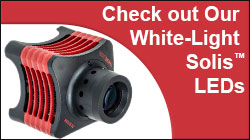

 Stabilized Deuterium UVLight Source
Stabilized Deuterium UVLight Source